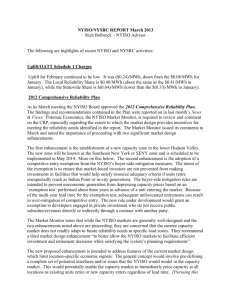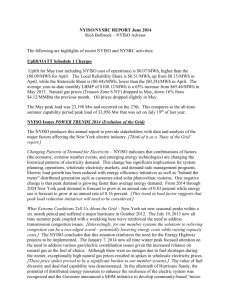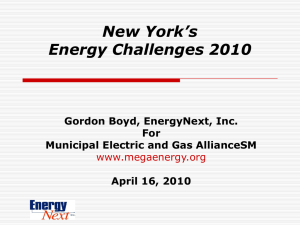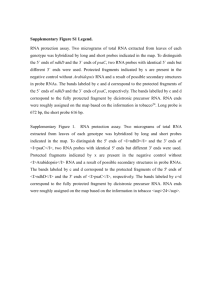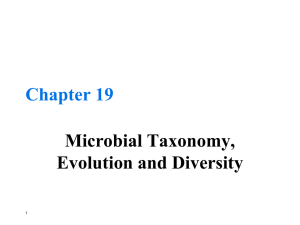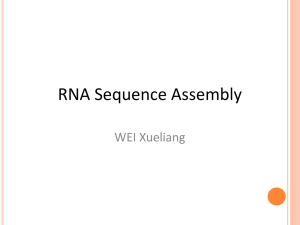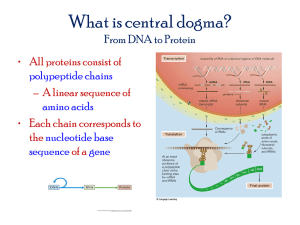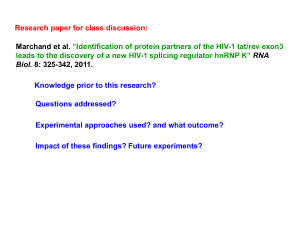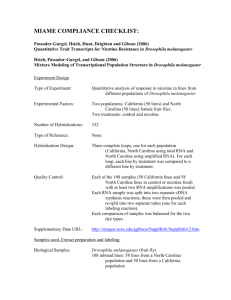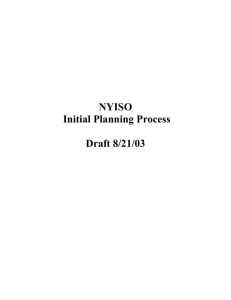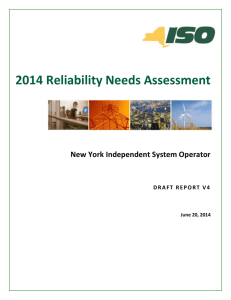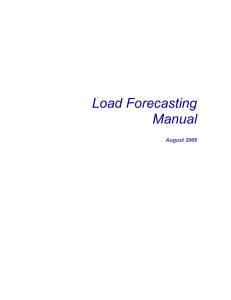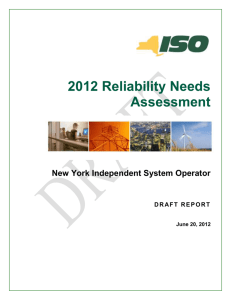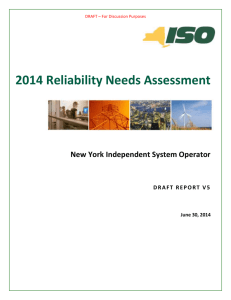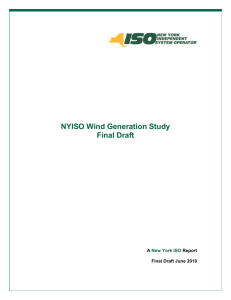Executive Summary
advertisement
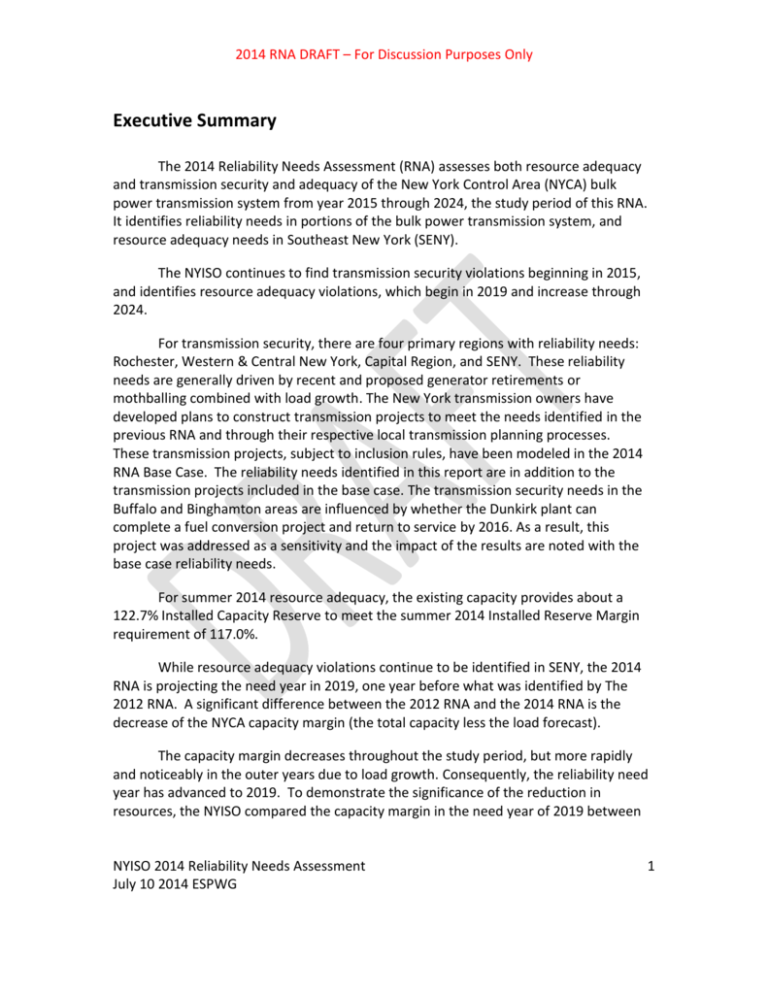
2014 RNA DRAFT – For Discussion Purposes Only Executive Summary The 2014 Reliability Needs Assessment (RNA) assesses both resource adequacy and transmission security and adequacy of the New York Control Area (NYCA) bulk power transmission system from year 2015 through 2024, the study period of this RNA. It identifies reliability needs in portions of the bulk power transmission system, and resource adequacy needs in Southeast New York (SENY). The NYISO continues to find transmission security violations beginning in 2015, and identifies resource adequacy violations, which begin in 2019 and increase through 2024. For transmission security, there are four primary regions with reliability needs: Rochester, Western & Central New York, Capital Region, and SENY. These reliability needs are generally driven by recent and proposed generator retirements or mothballing combined with load growth. The New York transmission owners have developed plans to construct transmission projects to meet the needs identified in the previous RNA and through their respective local transmission planning processes. These transmission projects, subject to inclusion rules, have been modeled in the 2014 RNA Base Case. The reliability needs identified in this report are in addition to the transmission projects included in the base case. The transmission security needs in the Buffalo and Binghamton areas are influenced by whether the Dunkirk plant can complete a fuel conversion project and return to service by 2016. As a result, this project was addressed as a sensitivity and the impact of the results are noted with the base case reliability needs. For summer 2014 resource adequacy, the existing capacity provides about a 122.7% Installed Capacity Reserve to meet the summer 2014 Installed Reserve Margin requirement of 117.0%. While resource adequacy violations continue to be identified in SENY, the 2014 RNA is projecting the need year in 2019, one year before what was identified by The 2012 RNA. A significant difference between the 2012 RNA and the 2014 RNA is the decrease of the NYCA capacity margin (the total capacity less the load forecast). The capacity margin decreases throughout the study period, but more rapidly and noticeably in the outer years due to load growth. Consequently, the reliability need year has advanced to 2019. To demonstrate the significance of the reduction in resources, the NYISO compared the capacity margin in the need year of 2019 between NYISO 2014 Reliability Needs Assessment July 10 2014 ESPWG 1 2014 RNA DRAFT – For Discussion Purposes Only the 2012 RNA and the 2014 RNA. The NYISO found a net decrease of 2,100 MW of resources, which breaks down as follows: 1. 2. 3. The NYCA capacity resources are 874 MW less for 2019 (724 MW upstate and 150 MW in SENY); The NYCA baseline load forecast is 250 MW higher for 2019 (497 MW higher upstate and 247 MW lower in SENY); and The NYCA Special Case Resources (SCRs) projection is 976 MW less for 2019 (685 MW upstate and 291 MW in SENY). The reliability needs identified in the 2014 RNA are summarized in Table 1 below, and the relative locations of the regions are marked on Figure 1. NYISO 2014 Reliability Needs Assessment July 10 2014 ESPWG 2 2014 RNA DRAFT – For Discussion Purposes Only Table 1: Reliability Needs identified in 2014 RNA Year of Need 2015 2016 2017 2018 2019 2020 2021 2022 2023 2024 Transmission Security Violations (Area/Load Zone/Transmission Owner) Rochester Area in Genesee (Zone B), owned by RG&E Binghamton Area in Central (Zone C), owned by NYSEG* Syracuse Area in Central (Zone C), owned by N. Grid Utica Area in Mohawk Valley (Zone E), owned by N. Grid Albany Area in Capital (Zone F), owned by N. Grid No additional violations Rochester Area issues mitigated Additional Syracuse Area in Central (Zone C), owned by N. Grid Additional Utica Area in Mohawk Valley (Zone E), owned by N. Grid* Binghamton Area voltage in Central (Zone C), owned by NYSEG Buffalo Area in Dysinger (Zone A), owned by N. Grid* No additional violations Additional Binghamton Area in Central (Zone C), owned by NYSEG* Additional Buffalo Area in West (Zone A), owned by N. Grid* Additional Buffalo Area in West (Zone A), owned by N. Grid* Transmission between Capital (Zone F) and Hudson Valley (Zone G), owned by N. Grid No additional violations No additional violations Resource Adequacy (LOLE) No violation Violation (LOLE = 0.11) Violation (LOLE = 0.13) Violation (LOLE = 0.15) Violation (LOLE = 0.18) Violation (LOLE = 0.22) Violation (LOLE = 0.26) * Some violations would be resolved upon the return of the Dunkirk plant to service. Figure 1: Map of Reliability Needs Identified in 2014 RNA Note: The red circles indicate the areas with transmission security violations and the blue circle represents the region with resource adequacy violations. NYISO 2014 Reliability Needs Assessment July 10 2014 ESPWG 3 2014 RNA DRAFT – For Discussion Purposes Only The NYISO expects the market and recent rule changes to help meet the resource capacity needs in SENY, as identified by this and the 2012 RNAs. The resource capacity needed downstream of upstate New York to SENY interface is approximately 1,200 MW. The new Zones G-J Locality will provide market signals for resources to provide service in this area. Capacity owners and developers are taking steps to return mothballed units to service, restore units to their full capability, or build new in the Zones G-J Locality. If some or all of these units return to service or are developed, the reliability need year would be pushed out beyond 2019. In addition, New York State government is promoting transmission development to relieve the transmission constraints between upstate and SENY, which could also defer the need for additional resources. The NYISO anticipates that such potential solutions will be submitted for evaluation during the solutions phase of the Reliability Planning Process (RPP) and documented in the upcoming 2014 Comprehensive Reliability Plan (CRP). As a backstop to market-based solutions, the NYISO employs a process to define responsibility should the market fail to provide an adequate solution to an identified reliability need. Since there are transmission security violations in Zones A, B, C, E, F, and G within the study period , the transmission owners (TOs) in those zones (i.e., National Grid, RGE, and NYSEG) will be responsible and tasked to develop detailed regulated backstop solutions for evaluation in the 2014 CRP. Given the limited time between the identification of certain reliability needs in this RNA report and their occurrence in 2015, the use of demand response and operating procedures may be necessary to maintain reliability during peak load periods until permanent solutions can be put in place. It is also expected that the TOs will present their updated Local Transmission Plans for these zones for consideration in the 2014 CRP. The NYISO identified reliability needs for resource adequacy in SENY starting in the year 2019; therefore, the TOs in SENY (i.e., Orange & Rockland, Central Hudson, New York State Electric and Gas, Con Edison, and LIPA) are responsible to develop the regulated backstop solutions. If the solution is non-transmission, these reliability needs can only be reasonably satisfied through the addition of compensatory megawatts in SENY because such resources need to be located below the Upstate New York to Southeast New York transmission interface constraint to be effective. Potential solutions could include a combination of additional transfer capability by adding transmission facilities into SENY from outside those zones and/or resources located within SENY. In addition, the 2014 RNA provides analysis of risks to the Bulk Power Transmission Facilities under certain sensitivities and scenarios to assist developers and stakeholders to propose market-based and regulated reliability solutions as well as policy makers to formulate state policy. The 2014 RNA analysis included scenarios to NYISO 2014 Reliability Needs Assessment July 10 2014 ESPWG 4 2014 RNA DRAFT – For Discussion Purposes Only address recent experiences in the NYISO operations, which revealed potential future reliability risks caused particularly by generation retirements, fuel availability, or other factors that could limit energy production during the winter seasons. The findings under the sensitivity and scenario conditions are: Dunkirk Fuel Conversion Project: The availability of Dunkirk after the fuel conversion project in 2016 resolves thermal transmission security violations in the Buffalo and Binghamton areas. High (econometric) Load Forecast: LOLE would exceed 0.1 day/year starting in 2017. Indian Point Energy Center Plant Retirement: Reliability violations would occur in 2016 if the Indian Point Plant were to be retired at the latter of the two units’ current license expiration dates. Zonal Capacity at Risk: For year 2015, removal of up to 2,500 MW in Zones A through F, 650 MW in Zones G through I, 650 MW in Zone J, or 550 MW in Zone K would result in a NYCA LOLE violation. Transmission Security under 90/10 Forecasted Load: The 90/10 forecast for the statewide coincident summer peak is on average approximately 2,400 MW higher than the baseline 50/50 forecast. This higher load would result in the earlier occurrence of the reliability needs identified in the base case as well as the occurrence of new violations in the same four primary regions. In addition, beginning in 2017 there would be insufficient resources to meet the minimum 10minute operating reserve requirement of 1,310 MW. Starting in 2020, there would be insufficient resources to even meet the modeled 90/10 peak load under normal conditions. Stressed Winter Scenario: The winter of 2013-2014 experienced five major cold snaps, including three polar vortexes that extended across much of the country. The NYISO set a new winter peak load of 25,738 MW while neighboring ISOs and utilities concurrently set record winter peaks during the month of January. Compounding the impact from high load conditions, extensive generation derates and gas pipeline constraints occurred simultaneously due to the extreme winter weather. In the extreme case that NYCA is unable to receive any emergency assistance from neighboring areas, loss of capacity in excess of 7,250 MW due to energy production constraints in extreme winter conditions could cause a LOLE criterion violation in 2015. NYISO 2014 Reliability Needs Assessment July 10 2014 ESPWG 5 2014 RNA DRAFT – For Discussion Purposes Only In addition to the scenarios, the NYISO also analyzed the risks associated with the cumulative impact of environmental laws and regulations, which may affect the flexibility in plant operation and may make fossil plants energy-limited resources. The RNA discusses the environmental regulations that affect long term power system planning and highlights the impacts of various environmental drivers on resource availability. The RNA is the first step of the NYISO reliability planning process. As a product of this step, the NYISO documents the reliability needs in the RNA report, which is presented to the NYISO Board of Directors for approval. The NYISO Board approval initiates the second step, which involves NYISO requesting proposed solutions to mitigate the identified needs to maintain acceptable levels of system reliability throughout the study period. As part of its ongoing reliability planning process, the NYISO monitors and tracks the progress of market-based projects, regulated backstop solutions, together with other resource additions and retirements. The other tracked resources include: (i) units interconnecting to the bulk power transmission system; (ii) the development and installation of local transmission facilities; (iii) additions, mothballs or retirement of generators; (iv) the status of mothballed/retired facilities; (v) the continued implementation of New York State energy efficiency programs; (vi) participation in the NYISO demand response programs; and (vi) the impact of new and proposed environmental regulations on the existing generation fleet. The results of the tracking process will be further analyzed and documented in the upcoming 2014 CRP. NYISO 2014 Reliability Needs Assessment July 10 2014 ESPWG 6
